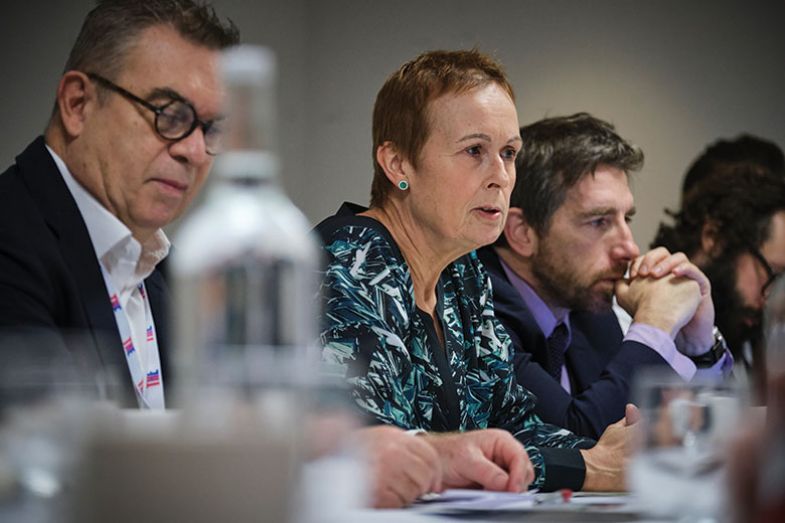
Source:
THE

A London Higher roundtable at THE Live highlighted the city’s higher education success stories and called for affordable student accommodation, more collaboration and the redistribution of wealth
London’s higher education institutions operate in a unique environment. There are unique opportunities and advantages but also persistent challenges, particularly regarding student satisfaction, maintaining the heterogeneity in a marketised sector, tackling the city’s social issues and widening access to university for under-represented groups.
At a roundtable event, hosted by London Higher, a group representing the interests of London’s higher education institutions, at THE Live 2019, industry delegates from the London cluster gathered to discuss the issues facing their institutions. London Higher’s chief executive, Jane Glanville (pictured), opened the discussion by outlining what set the London higher education sector apart. Many of the issues would be familiar to universities across the UK but are nonetheless exacerbated by the city’s scale and population dynamics.
“It is growing at a rate of around 70,000 residents a year,” she said. “There are 33 boroughs and our institutions have to deal with often more than one borough, if not multi-boroughs, and you can imagine the complexities. There are 73 parliamentary constituencies in London. It is a wealthy city, or so you would believe, and you would have to say that it is a thriving city. But there are many challenges. We have the highest number of children in poverty. We have some of the most deprived wards in the country. We have affluence next to deprivation.”
Growth of the commuter student
Ms Glanville highlighted the growth of the commuter student, with high rents causing more students to live outside of London’s metropolitan area. This has an impact on student experience.
Graeme Atherton, head of AccessHE and director of the National Education Opportunities Network at London Higher, noted that the city had a higher proportion of teenagers than anywhere else in the UK, and that London universities faced a lifecycle challenge.
Lynn Dobbs, vice-chancellor of London Metropolitan University, is at the vanguard of many of these challenges. London Met serves Hackney, Islington and Tower Hamlets, with 96 per cent of its students hailing from under-represented groups. “A lot of these students wouldn’t go to university if London Met wasn’t there,” she said. “They don’t have the confidence to travel to another university.” Professor Dobbs added that she had encountered students facing a number of serious issues, such as domestic abuse, homelessness and mental health concerns. “We do a good job,” she said. “It is something like 70 per cent of our students go into graduate jobs. There are some phenomenal success stories.”
Professor Dobbs’ experiences were shared by many in attendance. Anthony Browne, principal of Trinity Laban Conservatoire of Music and Dance, said that his institution actively engaged with schools, working with 11,000 children in the local community to improve access. Around 75 per cent of these children are from black, Asian and minority ethnic backgrounds, and Professor Browne said that his institution worked “intensely” to increase diversity in its student intake. But, as a conservatoire, it faced unique challenges. “In a conservatoire, there is no point giving a bursary to a person of 18 and saying, ‘We will educate you’,” he said. “If you can’t play your instrument very well by the age of 18, you can’t enter a conservatoire. The way to crack that is to start working with them at the age of five. That work is not often appreciated.”
Stephen Hopgood, deputy director of SOAS University of London, raised the importance of foreign students in financing much of the work that London’s universities do. The city is home to more than 115,000 international students from 200 countries. Finding the balance between serving an international market and the local community was crucial. “We should be honest: international students paying higher fees are an almost unavoidable part of our business model, and increasingly so – so that tension is there for all of us,” he said. “We could not survive on the basis of London-based students. We need international students paying high fees to cross-subsidise that.”
Tony Travers, a director of the London School of Economics and Political Science and visiting professor in its department of government, said that LSE was no different. All institutions are a mix of the international, the local and the very local, he said. Across the table, there were concerns about the certainty of the international student market post-Brexit. The diversity of London’s student population was seen as a potential solution to wider diversity issues in industry. Nick Johnstone, head of policy and advocacy at University of the Arts London, said that the mix of international and local enhanced the student experience. Wendy Thomson, vice-chancellor of University of London, agreed. Regarding the student experience, she said that more affordable accommodation was key.
Professor Dobbs said that London Met was increasing its efforts to improve the staff experience. “In all of the institutions I have worked at, when we got the staff happy, the National Student Survey scores went flying up,” she said.
There was a consensus that its heterogeneity made London's higher education ecosystem special. Professor Thomson urged more collaboration, believing that the marketisation of the sector in the city was a flash in the pan. Stuart Reid, principal of the Royal Veterinary College, said the London cluster needed to celebrate its success but that metrics were squashing the celebration of heterogeneity in higher education. Professor Hopgood added that the sector's ecosystem had to be supported "at the level of government policy”. “There has to be a mechanism within that for some degree of redistribution of the spoils," he argued. "If you’ve got juggernaut universities making large surpluses, who are benefiting, in part, because you can come to London and access this heterogeneity, they are going to have to pay something to keep that ecosystem going.”
The panel
John Gill, editor, Times Higher Education (chair)
Graeme Atherton, head, AccessHE; director, National Education Opportunities Network, London Higher
Peter Bonfield, vice-chancellor and president, University of Westminster
Anthony Browne, principal, Trinity Laban Conservatoire of Music and Dance
Lynn Dobbs, vice-chancellor, London Metropolitan University
Jane Glanville, chief executive, London Higher
Stephen Hopgood, deputy director, SOAS University of London
Nick Johnstone, head of policy and advocacy, University of the Arts London
Tom Morgan, director of communications, Goldsmiths, University London
Stuart Reid, principal, Royal Veterinary College, University of London
Alan Thompson, dean of the faculty of brain sciences; pro vice-provost for London, UCL
Wendy Thomson, vice-chancellor, University of London
Tony Travers, professor in practice, London School of Economics and Political Science
Join the THE Live mailing list here for all the latest THE Live news and exclusive offers.

